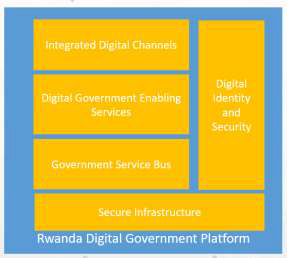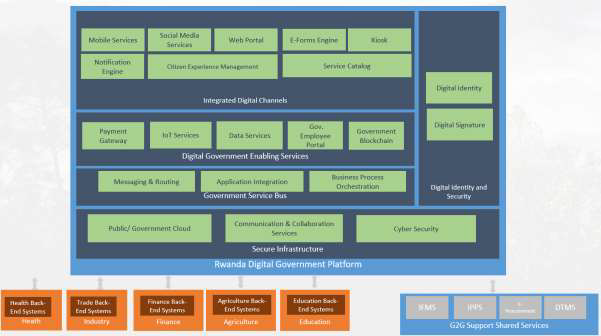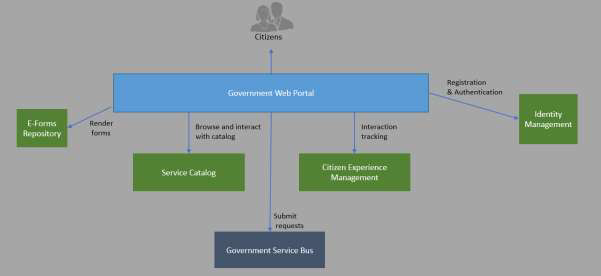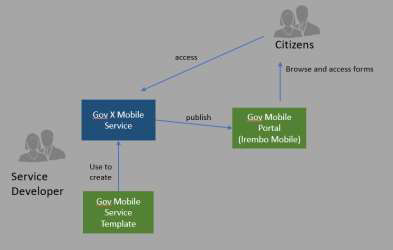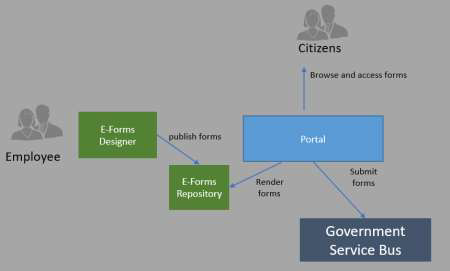Digital Government Platform Architecture
This section provides an overview of the proposed architecture for the Digital Government Platform.
Architecture Overview
The Digital Government Platform is not one single solution, but rather a set of technology components, architecture artefacts, and guidelines, that work together to facilitate all aspects related to building digital government services. The top-level components are listed below:
- Integrated Digital Channels: Allows citizens to have a seamless interaction with the government, leveraging latest devices, social media, and other channels to provide unified citizen experiences.
- Digital Government Enabling Services: Provide services such as payment, notification, and data management, to facilitate and accelerate the creation of digital services.
- Digital Identity and Security: provides technology-based solutions for authenticating citizens and ensuring the security of transactions.
- Government Service Bus: Accelerates the creation of new e-services through surfacing government data and processes, simplifying the creation of services that span multiple government entities.
- Secure Infrastructure: Provides the backbone of systems, hardware, networking, and security that ensures a reliable, secure, and low-cost operation of government services.
These components are further broken down in the following diagram:
These components are described below.
Integrated Digital Channels
-
-
-
Overview
-
-
Integrated Digital Channels provide the possibility for seamless interaction of citizens with the government using multiple channels. Government services will be accessible from any location, through multiple types of devices, using a consistent user experience that is also contextaware.
-
-
-
Government Web Portal
-
-
The single point of access to government services on the web is the government web portal. “Irembo” is the current implementation of the Government Web Portal.
Using the portal, citizens and businesses can:
- Get information on government and its services
- Browse the catalog of services and get redirected to the proper location for accessing services (refer to the catalog services section)
- Communicate directly with government entities
- Transact with the government services directly using e-services
The web portal would provide some additional features that help in ensuring the best user
experience for users:
- Integrate with Identity management to allow users to log in with chosen credentials and leverage single sign-on to access other services
- Transaction History: Provide users with a history of the transactions that they have conducted with the government
- Search: ability to search information available on the government portal as well as all government websites from a central place
- Chatting/Chatbots: Provide ability to do online chatting with government service representatives, potentially leveraging automated artificial intelligence-enabled chatbots in appropriate scenarios.
The following diagrams show the interaction of the portal with other components:
While Irembo already provides a good entry point to a number of government services, some enhancements are recommended to be put in the roadmap for it to act as a gateway:
- Integration with other government websites and services, including catalogs, yellow pages, search and sign-on capability across all government websites and other digital channels
- Omni-Channel Access: The ability to start a transaction on one channel and continue it on another, such as beginning a birth certificate request on a phone app and then completing it and submitting it through Irembo.
- Control of government entities over web form creation and maintenance, enabling the government entity owning the business to be able to manage the updates to the data and validation it requires from users. Refer to the e-Forms Engine section for details.
-
-
-
Mobile Services
-
-
More than 90% of Rwandans¹ access the Internet on their mobile devices. Therefore, it is natural that the interaction with the government should use mobile as the priority channel. Some government services are currently enabled on mobile using USSD. Irembo provides a responsive-design interface for rendering forms on small-screen devices, which helps significantly in making the e-services available on smartphones.
In addition to USSD apps and responsive web design, it is beneficial to create smartphone apps that provide a fluid and responsive mobile service to citizens. Creating one mobile app for government services would be desirable but is not feasible in practice, as it would provide significant challenges in terms of providing useful functionality that is easily accessible to citizens. Therefore, it is expected that multiple mobile apps would be created by the respective owners of services based on the needs.
In that context, centralized government mobile services would have the following objectives:
- Enable standardized mobile-based access to services. Standardization would cover security, communication, branding, and look-and-feel, among others.
- Ensure integration with other Digital Government Platform components, most notably, Identity Management and Single Sign-On on mobile devices, so that citizens can access mobile services using their assigned credentials.
- Provide a central place (portal) for discovering and accessing mobile apps for government. The portal would be accessible through Irembo and as a mobile app used for launching other government apps.
- Provide guidance, standards, and templates to government entities and third-party developers for building cross-platform mobile services. These would help ensure consistency even if the development of mobile app is created by multiple developers or vendors, as it is expected.
-
-
-
Social Media Services
-
-
-
- Communicate frequently and announce on events and news:Social networks provide an opportunity to raise awareness about what’s happening with citizens
- Openly listen and respond to citizen queries and feedback: Social networks contain a trove of information about citizens and government services. Addressing comments quickly can turn a good or bad citizen experience into long-term satisfaction. It also helps identify the things citizens care about. Social communities can also be a great source of highly detailed feedback and discussion from the people who use government services the most.
- Analyze general sentiment and context-specific sentiment: Analyzing social streams allows the government to gather information, intelligence, and insights—leveraging connections with citizens and other organizations at local, national, and international levels.
Within the Digital Government Platform, Social Media Services provide the policies, procedures, and tools for a government agency to achieve the above objectives. It also integrates social media with other components, including the web portal, mobile services, and citizen experience management.
-
-
-
E-forms Engine
-
-
Automating government paper forms is a common requirement in accelerating the digitization of government business. At the moment, the Irembo team creates online forms for e-services, which requires an extensive programming effort, with the government entities having no control over form fields and validations. It is desirable to have a way to accelerate the form
creation and make it easy to publish and update government forms.
The e-Forms Engine complements the government web portal by providing a system for hosting e-form templates, a designer for templates creation and functionality that allows rendering e-forms in web browsers. The features from the e-Forms engine would be:
- Simplify the creation of online forms following a standardized visual design
- Simplify the submission of forms to web services for processing
- Allow rendering of forms on multiple devices
- Provide a centralized repository of forms
Two main components are there:
- The e-forms Designer: supports easy creation of e-Form
- It should be possible to create a form which will look like the paper version of
the form - No deep technical knowledge or programming required
- Should support multiple languages
- Allow entry validation
- Allow complex logic and calculation
- Ability to call web services during e-Form filling
- It should be possible to create a form which will look like the paper version of
- The e-forms repository provides central repository of published e-Forms templates. Through web services it allows communication with e-Forms Designer and with the portal that is responsible for hosting e-Form Renderer and which is responsible for showing the list of templates.
Service Catalog
Hosted within the government web portal and mobile services, the Service Catalog provides a central place for citizens to learn about and navigate government services. It facilitates three main ways to browse services:

